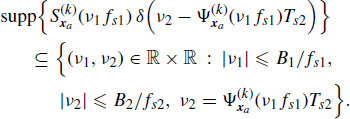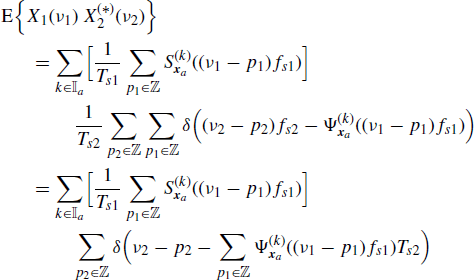5.10 Proofs for Section 4.9 “Sampling of SC Processes”
5.10.1 Proof of Theorem 4.9.2 Strictly Band-Limited Spectrally Correlated Processes
The strictly band-limitedness condition (4.204) considered in the frequency domain implies that
where ![]() . In the case of jointly SC processes, replacing (4.209a) into (5.179) leads to
. In the case of jointly SC processes, replacing (4.209a) into (5.179) leads to
Let
(5.181) ![]()
(5.182) ![]()
Without lack of generality, the functions ![]() and
and ![]() in (4.209a) and (4.209b) can be chosen such that both
in (4.209a) and (4.209b) can be chosen such that both ![]() and
and ![]() are at most countable (Definition 4.2.4 and Theorem 4.2.7). Let us assume that the number of possible accumulation points (cluster points) of
are at most countable (Definition 4.2.4 and Theorem 4.2.7). Let us assume that the number of possible accumulation points (cluster points) of ![]() and
and ![]() is at most finite. Thus, from (5.180) it necessarily results that
is at most finite. Thus, from (5.180) it necessarily results that ![]()
(5.183) ![]()
where ![]() , with cl denoting set closure, represents the set of points fi where there is no curve intersection (or accumulation points of such fi). Consequently, condition in (4.210a) holds almost everywhere (a.e.). However, since
, with cl denoting set closure, represents the set of points fi where there is no curve intersection (or accumulation points of such fi). Consequently, condition in (4.210a) holds almost everywhere (a.e.). However, since ![]() is at most countable and with at most a finite number of accumulation points, the cross-correlation (4.24b) (with
is at most countable and with at most a finite number of accumulation points, the cross-correlation (4.24b) (with ![]() ) is not modified by assuming
) is not modified by assuming ![]() also for f1 such that |f1| > B1 and
also for f1 such that |f1| > B1 and ![]() . Therefore, we can assume that (4.210a) holds everywhere using suitable modifications of
. Therefore, we can assume that (4.210a) holds everywhere using suitable modifications of ![]() . Furthermore, from (5.180) it follows that for strictly band-limited SC processes the functions
. Furthermore, from (5.180) it follows that for strictly band-limited SC processes the functions ![]() are undetermined for
are undetermined for ![]() . Thus,
. Thus, ![]() for
for ![]() can be assumed in order to have these functions with compact support. The proof of (4.210b) is similar and, analogously,
can be assumed in order to have these functions with compact support. The proof of (4.210b) is similar and, analogously, ![]() can be assumed for
can be assumed for ![]() .
.
The proof of the converse is straightforward.
5.10.2 Proof of Theorem 4.9.4 Loève Bifrequency Spectrum of Sampled Jointly Spectrally Correlated Processes
The Fourier transform (4.185) of the sequence xi(n) is linked to the Fourier transform (4.5) of the continuous-time signal xa,i(t) by the relationship (Lathi 2002, Section 9.5)
Thus, accounting for (4.209a), one obtains
from which (4.213) follows by a scale change in the argument of the Dirac delta (Zemanian 1987, Section 1.7).
5.10.3 Proof of Theorem 4.9.5 Loève Bifrequency Spectrum of Sampled Strictly Band-Limited Jointly SC Processes
For strictly band-limited processes xa,i(t), according to Corollary 4.9.3, the support of the replica with p1 = p2 = 0 in (4.213) is such that
(5.186) 
Since the functions ![]() have compact support contained in [− B1, B1], are invertible, and have values in [− B2, B2] (Theorem 4.9.2), under the assumption fsi ≥ 2Bi, the result is that for every
have compact support contained in [− B1, B1], are invertible, and have values in [− B2, B2] (Theorem 4.9.2), under the assumption fsi ≥ 2Bi, the result is that for every ![]() and
and ![]() there exists only one pair (ν1, ν2)
there exists only one pair (ν1, ν2) ![]() [p1 − 1/2, p1 + 1/2) × [p2 − 1/2, p2 + 1/2) such that
[p1 − 1/2, p1 + 1/2) × [p2 − 1/2, p2 + 1/2) such that ![]() in the argument of the Dirac delta in the right-hand side of (5.185). Consequently, (5.185) can be written as
in the argument of the Dirac delta in the right-hand side of (5.185). Consequently, (5.185) can be written as
from which (4.190a) with (4.220a) and (4.221a) immediately follow. In addition, since replicas in (5.187) are separated by 1 in both variables ν1 and ν2 and the functions (of ν1) ![]() and
and ![]() have compact support contained in [− B1/fs1, B1/fs1], condition fs1 ≥ 2B1 assures that replicas in (4.220a) and (4.221a) do not overlap.
have compact support contained in [− B1/fs1, B1/fs1], condition fs1 ≥ 2B1 assures that replicas in (4.220a) and (4.221a) do not overlap.
The proof of (4.190b) with (4.220b) and (4.221b) is similar.
5.10.4 Proof of Theorem 4.9.6
Let us assume that fsi ≥ 2Bi, (i = 1, 2). Thus, according to Theorem 4.9.5, replicas in (5.187) do not overlap. However, mappings (4.222), (4.223) do not necessarily hold ∀ν1 ![]() [− 1/2, 1/2].
[− 1/2, 1/2].
From fs1 ≥ 2B1 it immediately follows that ∀ν1 ![]() [− 1/2, 1/2]
[− 1/2, 1/2]
Due to condition (4.226) for ![]() , it results that ∀ν1
, it results that ∀ν1 ![]() [− 1/2, 1/2]
[− 1/2, 1/2]
Then in (5.187), for ν1 ![]() [− 1/2, 1/2] the support curve
[− 1/2, 1/2] the support curve ![]() of the replica with p1 = p2 = 0 can overlap support curves of other replicas (p1 ≠ 0 and/or p2 ≠ 0) only if on these other curves the spectral correlation density is zero. In fact, 1 − B1/fs1 [1 − B2/fs2] is the smallest |ν1| [|ν2|] such that replicas with p1 = ± 1 [p2 = ± 1] can have nonzero spectral correlation density. Thus conditions (4.222), (4.223) hold ∀ν1
of the replica with p1 = p2 = 0 can overlap support curves of other replicas (p1 ≠ 0 and/or p2 ≠ 0) only if on these other curves the spectral correlation density is zero. In fact, 1 − B1/fs1 [1 − B2/fs2] is the smallest |ν1| [|ν2|] such that replicas with p1 = ± 1 [p2 = ± 1] can have nonzero spectral correlation density. Thus conditions (4.222), (4.223) hold ∀ν1 ![]() [− 1/2, 1/2]. (5.188) and (5.189) holding
[− 1/2, 1/2]. (5.188) and (5.189) holding ![]() prove sufficiency of condition (4.226).
prove sufficiency of condition (4.226).
Analogous considerations lead to prove sufficiency of condition (4.227).




